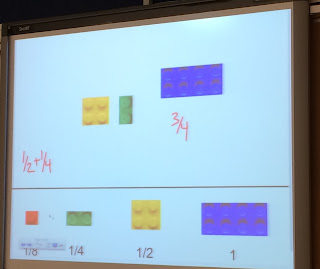This week we discussed many things in class and in the readings. We looked at decimals and fractions, and how to add, subtract, multiply, and divide decimals and fractions. It was a great review for me, since I have not done this type of math in many years, only having to add decimals occasionally when paying bills. Having to actually figure out how to use the different operations to solve the problems without a calculator was a bit challenging for me in the beginning, but after viewing some of the great tips that my peers taught, I am more confident in my own abilities to solve these kinds of problems, which means I will be able to effectively teach my own students these great ways to solve math problems involving fractions and decimals.
We looked at some really great ways to subtract decimals. We were shown many different visual aids to solve these problems, which I will definitely be using in my own instruction. I think they're great for students, especially for visual learners. We coloured in 10x10 grids and then took away the amount we were subtracting. This was the same concept, but we used physical blocks as the manipulative (which is a great method for tactile learners). I think it is really good to know these methods, especially for students who struggle with subtracting decimals. Another great method for adding and subtracting decimals is the use of money, since we all use money, and kids are generally fascinated by the concept of money, I think I will use this method when teaching about decimals. Since quarters, dimes, and pennies are in the decimals, it is a good visual for students. This will also help them with a real life situation that students crave (students generally don't want to learn math because they say they will "never use it in everyday life"). We also looked at how to multiply and divide decimals. I forgot about some of these helpful methods, so it was a good refresher to have. Multiplying and dividing decimal numbers is the same as multiply and dividing whole numbers, you just have to ignore the decimal until you have solved the problem, and then add it in its appropriate place. One method that I particularly enjoyed was using the 10x10 grid and colouring in the first amount and then dividing it.
 |
| Woolley, E. © 2015 |
It was a great visual aid, and I personally understood what it meant to divide decimal numbers. It kind of blew my mind, which is why I really like this method. Understanding that dividing is just grouping the first number into groups of the second number really helped, and this method actually showed me this. Hopefully my students will understand much better, like I did, by using this method.
Another cool method was using the smartboard as a visual. Instead of using physical objects, one person showed us how to use images that represent fractions. This was something that shocked everyone in the class, and I think we will all want to learn how to use smartboards to show our students how to add/subtract fractions using visuals.
 |
| Woolley, E. © 2015 |
No comments:
Post a Comment